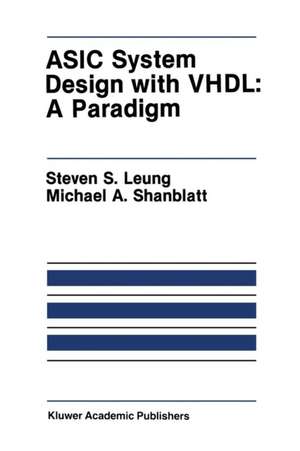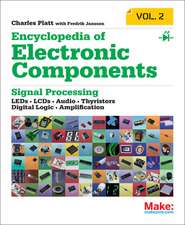ASIC System Design with VHDL: A Paradigm: The Springer International Series in Engineering and Computer Science, cartea 75
Autor Steven S. Leung, Michael A. Shanblatten Limba Engleză Paperback – 18 mai 2012
Din seria The Springer International Series in Engineering and Computer Science
- 24%
 Preț: 1041.98 lei
Preț: 1041.98 lei - 20%
 Preț: 643.50 lei
Preț: 643.50 lei - 18%
 Preț: 1225.62 lei
Preț: 1225.62 lei - 18%
 Preț: 965.02 lei
Preț: 965.02 lei - 20%
 Preț: 646.12 lei
Preț: 646.12 lei - 18%
 Preț: 948.79 lei
Preț: 948.79 lei - 20%
 Preț: 646.62 lei
Preț: 646.62 lei - 15%
 Preț: 637.46 lei
Preț: 637.46 lei - 20%
 Preț: 643.83 lei
Preț: 643.83 lei - 18%
 Preț: 949.23 lei
Preț: 949.23 lei - 20%
 Preț: 644.48 lei
Preț: 644.48 lei - 20%
 Preț: 994.92 lei
Preț: 994.92 lei - 20%
 Preț: 645.97 lei
Preț: 645.97 lei - 18%
 Preț: 946.87 lei
Preț: 946.87 lei - 20%
 Preț: 995.57 lei
Preț: 995.57 lei - 18%
 Preț: 956.99 lei
Preț: 956.99 lei - 20%
 Preț: 644.98 lei
Preț: 644.98 lei - 15%
 Preț: 649.54 lei
Preț: 649.54 lei - 18%
 Preț: 950.21 lei
Preț: 950.21 lei - 18%
 Preț: 1221.38 lei
Preț: 1221.38 lei - 18%
 Preț: 957.62 lei
Preț: 957.62 lei - 15%
 Preț: 643.99 lei
Preț: 643.99 lei - 18%
 Preț: 948.47 lei
Preț: 948.47 lei - 18%
 Preț: 947.35 lei
Preț: 947.35 lei - 20%
 Preț: 1284.65 lei
Preț: 1284.65 lei - 20%
 Preț: 1628.31 lei
Preț: 1628.31 lei - 20%
 Preț: 1285.78 lei
Preț: 1285.78 lei
Preț: 637.46 lei
Preț vechi: 749.95 lei
-15% Nou
Puncte Express: 956
Preț estimativ în valută:
121.98€ • 130.44$ • 101.70£
121.98€ • 130.44$ • 101.70£
Carte tipărită la comandă
Livrare economică 18 aprilie-02 mai
Preluare comenzi: 021 569.72.76
Specificații
ISBN-13: 9781461564751
ISBN-10: 1461564751
Pagini: 236
Ilustrații: 232 p. 20 illus.
Dimensiuni: 155 x 235 x 12 mm
Greutate: 0.34 kg
Ediția:Softcover reprint of the original 1st ed. 1989
Editura: Springer Us
Colecția Springer
Seria The Springer International Series in Engineering and Computer Science
Locul publicării:New York, NY, United States
ISBN-10: 1461564751
Pagini: 236
Ilustrații: 232 p. 20 illus.
Dimensiuni: 155 x 235 x 12 mm
Greutate: 0.34 kg
Ediția:Softcover reprint of the original 1st ed. 1989
Editura: Springer Us
Colecția Springer
Seria The Springer International Series in Engineering and Computer Science
Locul publicării:New York, NY, United States
Public țintă
ResearchCuprins
1. Introduction.- 1.1 Problem Statement.- 1.2 Approach.- 1.3 Organization of this Book.- 2. Background.- 2.1 The ASIC Challenge.- 2.2 Computer Architecture Design for Robotic Control.- 2.3 Robotic Kinematics.- 2.4 Summary.- 3. A Conceptual Framework for ASIC Design.- 3.1 The Nature of ASIC Design.- 3.2 The ASIC Design Process.- 3.3 The ASIC Design Hyperspace.- 3.4 The ASIC Design Repertoire.- 3.5 Summary.- 4. The IKS Chip Design Paradigm.- 4.1 Introduction.- 4.2 An ASIC Architecture Design Methodology.- 4.3 The IKS Chip Architecture Design.- 4.4 Summary.- 5. VHDL Simulation of the IKS Chip.- 5.1 Introduction.- 5.2 VHDL Fundamentals.- 5.3 Simulation Objective and Modeling Approach.- 5.4 VHDL Description of the IKS Chip.- 5.5 Simulation Results.- 5.6 Summary.- 6. Conclusion.- 6.1 Summary.- 6.2 Implications and Future Research.- Appendices.- Appendix A. The Closed Form IKS Algorithm for the PUMA.- Appendix B. The IKS Algorithm in Pseudocodes.- Appendix C. Control Signal Definition.- Appendix D. The MACC Encoding Scheme and Code-Maps.- Appendix E. The MACC Microcode for Computing the IKS.



















